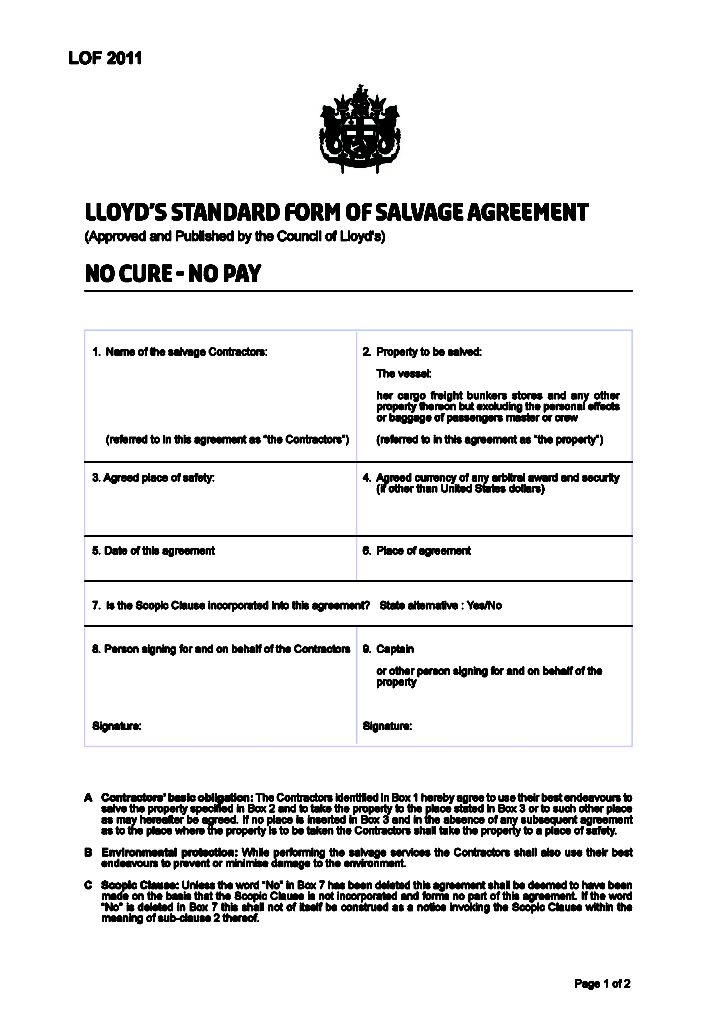
Salvage and the essential elements in a salvage service
“Salvage” is a service rendered by a person who saves or helps to save any maritime property in danger. Salvage must be considered from three legal aspects
• The common law aspect;
• The statutory aspect; and
• The contractual aspect.
There is also a practical seamanship aspect to all salvage operations.
Essential elements in a salvage service are, as per common law, any salvage service rendered will not qualify for a salvage reward unless it is rendered voluntarily. The salvage service must be rendered to a recognized subject of salvage. The subject must be in danger and the salvage service must be successful. A court applies the above common law principles in the absence of any express contractual terms and where no overriding statutory provisions like the Merchant Shipping Act are applicable.
Under volunteering service, the person rendering the salvage service must be a volunteer i.e.he must be under any pre-existing contract or statutory duty to render the service. The crew of the ship cannot therefore claim salvage reward in respect of their own ship unless the crew agreement has been terminated either expressly or by implication or in some cases the services rendered are excess of what could be reasonably expected of the crew under the contract. Harbour tugs and pilots are in a similar position.
However tugs sailed in an emergency would be “volunteers” and tugs engaged on a previously arranged towing contract are not “volunteers”.
Salvage services can only be rendered to “maritime property” i.e. property at risk of being lost if the salvage service is not rendered. Maritime property includes vessels, their equipment, cargo, bunkers, wreck and the freight that could be lost by non-completion of the voyage.
Ship’s provisions, passengers’ and crew’s personal effects, and other properties saved at sea like navigational buoys etc. do not qualify for salvage rewards. The saving of life called “life salvage” may qualify for a reward provided property is also saved along with the life.
A salvage award is also payable in respect of aircraft in danger of being lost at sea.
When we talk of a danger, it must be such that any prudent master would consider it reasonable to accept an offer of salvage assistance. This means the real peril must be threatening the property at the commencement of the salvage service but need not be present or imminent. A typical case may be a vessel, which has lost her propeller at sea and will eventually run aground. In this case although the danger may not be imminent, it makes an imperative case of call of assistance.
For the salvage operation the salvage reward is payable out of the value of the property saved. It means that unless something of value is saved, there can be no salvage award. This is what is known as the “no-cure no-pay” salvage. The service may not be entirely successful for the reward to be given as long as some thing of value to pay the reward is salvaged.


Advantages of using LOF (Lloyd’s Standard Form of Salvage Agreement or Lloyd’s Open Form)
The advantages of using LOF are:
• The agreement can be reached by radio if witnessed or other telecom methods. There is no need to sign the form until the salvage services are completed;
• The agreement is not likely to be disputed;
• LOF is basically a “no-cure, no-pay” agreement;
• English laws applies to claims;
• Salvor has a maritime lien on the property saved, even after its sale to other party;
• Salved property can be quickly released on payment of security to the salvor;
• Salvor gets an interim award;
• Disputes are referred to arbitration in London, saving legal costs;
• Underwriter’s liabilities cannot be increased beyond the total loss; and
• Excessive claim by the salvor can be avoided.
Qualify for a salvage reward

To qualify for a salvage reward, salvage services must be rendered. A vessel standing by to render the salvage service is not entitled to any reward. The salvor must salvage something of value to pay for the reward. The size of the reward will depend on many factors including the degree of danger, the enterprise and the skill of the salvors, the degree of risk to which the salvors are exposed, the extent of labour of the salvors, the risk of the salvors property, the value of property saved and the loss, if any, incurred by the salvors.
If a merchant ship has rendered the salvage service the salvage reward is normally divided between the ship owner, charterer, if any, master and the crew. The proportion will depend on the degree of efforts put by each. Although there are no hard and fast rules, traditionally the ship owner has been paid 3/4th of the reward, and the remaining quarter going to the master and the crew. Of that 1/4th one third goes to the master and the remaining two third being divided between the officers and crew in proportion to their rates of wages.
Assuming a reward of USD 120,000/=, following would be pattern of distribution:
• Owner’s share ¾ of total = USD 90,000
• Master and crew’s share = USD 30,000 (1/4th of total)
The master and crew’s share should be distributed as follows:
• Master’s share (1/3rd) = USD 10,000
• Crew’s share (2/3rd) = USD 20,000.